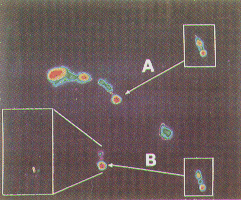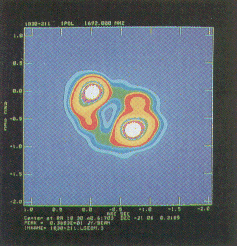

In 1979 Jodrell Bank astronomers and their optical colleagues discovered the first gravitational lens. Early this century Albert Einstein predicted that rays of light could be bent by a gravitational field, and realised that in certain circumstances stars and galaxies should act like lenses and form images of objects behind them.
The astronomers were searching for optical counterparts to radio sources discovered in a new survey at Jodrell Bank. At the position of one source they found what appeared to be a double quasar, with star-like images only a few arcseconds apart. To their surprise, the spectra of the images were almost identical, and they surmised that they were seeing not quasars, but two images of the same quasar, produced by a gravitational lens.
 The double quasar 0957+561 observed with MERLIN. High-resolution VLBI images of the two components are shown in the boxes. |
 A gravitational lens distorts this quasar into a shape known as an Einstein ring. |
Further work by astronomers all over the world confirmed that the quasar's light was being distorted by a cluster of galaxies dominated by a massive elliptical galaxy lying very close to the line of sight.
About ten gravitational lenses have been discovered. Radio observations are vital for understanding how they work, and only interferometers like MERLIN have sufficient resolving power to study them in detail. This is a MERLIN picture of the original double quasar, showing the two images of the quasar's bright core, A and B, and a radio jet issuing from A. The inset picture, made with the Europeon VLBI network (p. 14),reveals that both A and B contain a core plus a jet. The small differences between the images are distorting effects of the lens, and help astronomers measure the distribution of mass in the intervening galaxy.

Gravitational lens. Light from a distant quasar can be bent by a massive object lying close to the line of sight, giving the appearance of a double quasar.